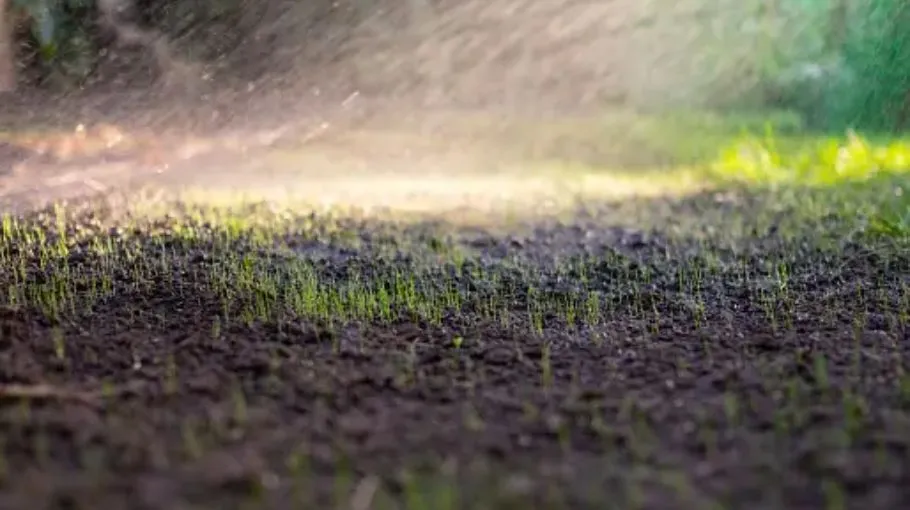Establishing a new lawn begins with planting grass seed, but one of the most critical factors in ensuring your success is knowing how often to water new grass seed . Proper watering is essential for seed germination and establishing a healthy lawn. In this guide, we’ll break down everything you need to know about watering new grass seed, from the initial stages to ongoing care.
The Germination Process and the Role of Water
Grass seeds require moisture to germinate effectively. Understanding the germination process can help you grasp the importance of proper watering:
- Water Absorption: Seeds need to absorb water to swell and break open their protective coating. This process is crucial for initiating germination.
- Temperature: The ideal soil temperature for germination varies by grass type, generally between 50°F and 65°F (10°C to 18°C).
- Oxygen: While water is essential, seeds also need oxygen for healthy growth, which is why well-drained soil is important.
Without sufficient moisture, seeds may fail to germinate or establish roots, leading to patchy growth and a weak lawn.
Initial Watering: The First Step to Success
After planting your grass seed, the initial watering sets the stage for successful germination:
- Thorough Soaking: Immediately after sowing, water the area thoroughly. The goal is to moisten the top 2 to 4 inches of soil, where the seeds are located.
- Frequency: For the first week, water daily. Light, consistent watering helps maintain the soil's moisture level without causing puddles or runoff.

Establishing a Watering Schedule
As your grass begins to germinate, you can adjust your watering routine:
Weeks 1-2: Daily Watering
In the first two weeks, it’s critical to keep the soil moist. Watering should occur daily, ideally in the early morning. This routine promotes optimal conditions for seed germination.
Weeks 3-4: Transition to Every Other Day
Once you see new grass blades emerging, you can shift to watering every other day. This allows the grass to develop while still providing adequate moisture. Aim for 5 to 10 minutes of watering during each session.
Week 5 and Beyond: Deep Watering
After about four weeks, your grass should be more established. At this stage, you can transition to deep watering every 3 to 4 days. This means watering for longer periods (about 20 to 30 minutes) to encourage deep root growth, which is essential for a robust lawn.
Factors That Influence Watering Frequency
Several factors can affect how often you should water new grass seed:
- Soil Type: Sandy soils dry out quickly, requiring more frequent watering, while clay soils retain moisture longer.
- Weather Conditions: Hot and windy days may necessitate additional watering, while cooler, humid conditions can allow for less.
- Grass Type: Different grass varieties have varying water requirements. Research the specific needs of the grass you are planting.
Recognizing Underwatering and Overwatering
It's essential to be able to identify the signs of both underwatering and overwatering:
Signs of Underwatering
- Slow Germination: If seeds take longer than expected to sprout, they may be too dry.
- Sparse Growth: Grass appears thin and weak.
- Dry Soil: The soil feels dry and crumbly when checked.
Signs of Overwatering
- Seed Rot: Excess moisture can lead to seeds rotting in the ground.
- Soggy Soil: Waterlogged soil is a sign of overwatering.
- Fungal Issues: The presence of mold or mildew indicates too much moisture.
Tips for Effective Watering
To ensure your new grass seed gets the moisture it needs, consider these practical tips:
- Use a Sprinkler or Soaker Hose: These tools help distribute water evenly and minimize evaporation, ensuring all areas receive moisture.
- Water Early in the Day: Morning watering is ideal as it allows the grass to absorb moisture before the heat of the day and reduces evaporation.
- Check Soil Moisture Regularly: Use your finger to check the soil moisture a couple of inches below the surface. If it feels dry, it’s time to water.
- Avoid Watering Late at Night: Watering in the evening can leave grass wet overnight, promoting fungal diseases.
Conclusion
Knowing how often to water new grass seed is essential for establishing a healthy, lush lawn. By following the guidelines in this article, you can create the perfect environment for your seeds to germinate and thrive.
For more expert advice and tips on lawn care, visit us at perfectgreenyard.com. With the right watering routine and care, you can achieve the vibrant green yard you’ve always desired!